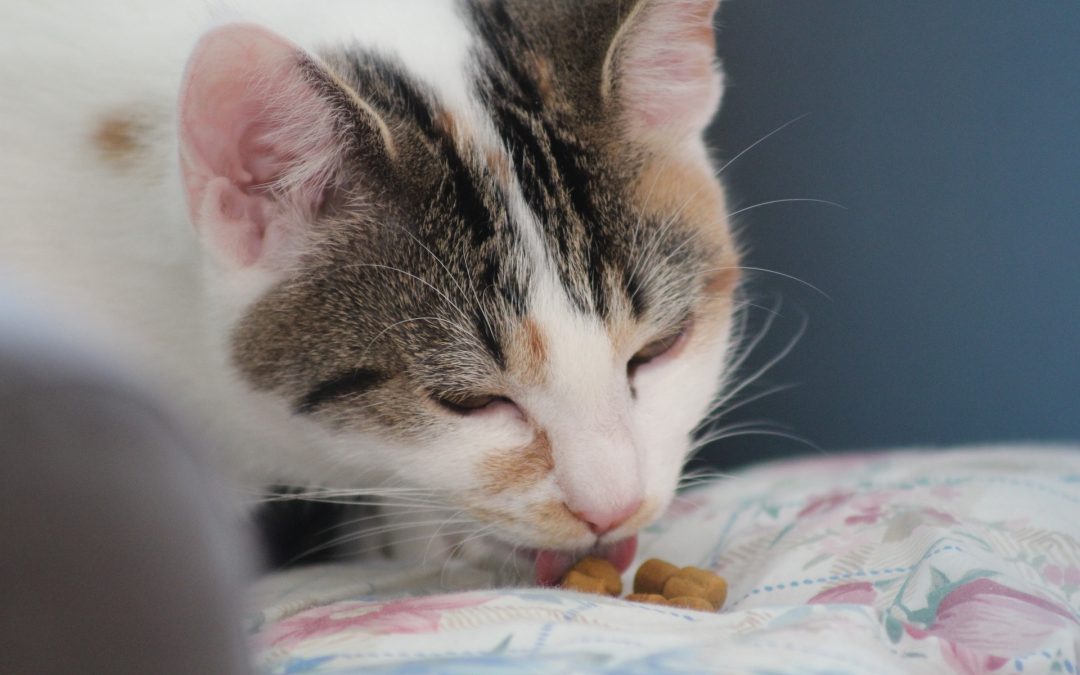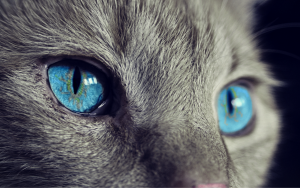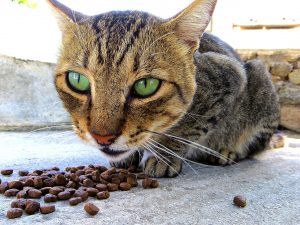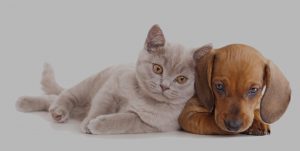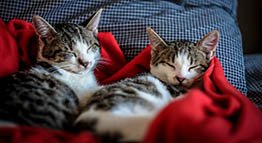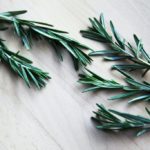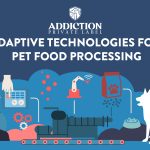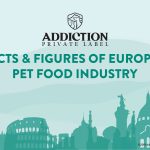By Andrew Prest, PhD Microbiology
The interest in the adequacy of commercially available pet foods has been growing worldwide, most commercially available cat food contains much more carbohydrate than the 12% carbohydrate exploited as part of a cats’ natural predatory instinct (dried cat food can contain up to 33% carbohydrate).
The natural diet of a cat consists of 52% protein, 36% fat and 12% carbohydrate. Cats present significant differences in digestive-related processes to dogs and humans. While cats are carnivorous, dogs appear to be omnivorous like human beings. Thiamine requirements also significantly differ between cats and dogs.
Like dogs, cats are monogastric and cannot synthesize thiamine, and because it is a water-soluble vitamin, there is no long-term storage in the body. Cat food should contain at least 5 mg/kg (verses 1 mg/kg thiamine on a dry matter basis for and dogs). It is therefore essential to study pet nutrition considering dogs and cats and the impact of functional foods separately.
As described in the previous article, a functional food is defined as ‘an ordinary food that has components or ingredients added to give it a special medical or physiological benefit, other than purely nutritional.
Functional foods and functional ingredients in humans have been strongly appreciated for their health benefits for at least two decades. These include:
- fruit and vegetables – high in dietary fibre, prebiotics and bio-active compounds (e.g. anti-oxidants),
- botanicals (such as plant extracts) – very high in bio-active compounds
- whole grains – high in dietary fibre and bio-active compounds
- dietary supplements including pycnogenol, collagen, coenzyme Q10, low-molecular-weight hyaluronic acid, chondroitin sulphate and glucosamine sulphate – primarily derived from meat and seafood by-product sector
- prebiotics – present in and primarily derived from Fruit and Vegetables in particular
- probiotics – can be manufactured
The gut microbiology of cats (and dogs) is very similar to that of humans (with predominance of Firmicutes, Bacteroidetes, Proteobacteria and Actinobacteria) and as a result cats and dogs serve to benefit from dietary fibre and pre- and probiotic interventions in particular.
The role of functional foods in domestic cats has been investigated in order to better understand their metabolism, thus optimising companion animal nutritional and health status. Functional foods and ingredients modify gastrointestinal physiology, promote changes in biochemical parameters, improve brain functions and may reduce or minimize the risk of developing specific diseases.
The use of apple pomace (a significant waste or by-product of the apple processing industry) has been studied and found to have significant functional food benefit with regard to obesity and energy density management in cats(1).
1. Apple pomace
Prebiotics and probiotics have been shown to have some benefits on the gut and have been proposed as adding value to pet food preparations. A prebiotic is a non-digestible food ingredient that beneficially affect the host by selectively stimulating the growth and/or activity of one or a limited number of bacteria in the colon
A number of studies on dogs and cats has shown beneficial effects from the administration of prebiotics, such as FOS and inulin. The main effects reported include modification of the large intestinal microflora to encourage the growth of beneficial bacteria to the exclusion of potential pathogens. The most adverse effect of over consumption of prebiotics is gastrointestinal intolerances.
Apple pomace is a heterogeneous mixture consisting of apple peel, core, seed, calyx, stem, and soft tissue. Apple pomace contains 26.4% dry matter (DM), 4.0% proteins, 3.6% sugars, 6.8% cellulose, 0.38% ash, 0.42% acid and calcium. Apple pomaces contains relatively high quantities of dietary fibre and pectic-oligosaccharides (prebiotics). Applications and benefits of pectic oligosaccharides also protect colonocytes against Escherchia coli verocytotoxins and stimulate apoptosis in human colonic adenocarcinoma cells.
In the referenced study low digestible apple pomace was mixed with a meat-based diet at an inclusion level of 10, 20, and 40% and fed to 9 adult neutered European shorthaired obese cats (Fekete et al., 2001). Inclusion of apple pomace up to 20% of the diet did not decrease food palatability, reduced the energy density, slightly changed the digestibility of fat, and considerably decreased the digestibility of crude protein. Energy density decreased proportionally to the percentage of apple pomace added to the diet. The authors concluded that inclusion of palatable fibrous components at a restricted inclusion rate in the diet of obese cats represents a good way to reduce food energy content and maintain a physiological level of food intake.
Examples of functional foods derived from the cereal food sector include rice bran:
2. Rice Bran and Taurine
Rice bran is an excellent source of essential amino acids since it is particularly rich in sulfur-containing amino acids, micronutrients such as magnesium, manganese and B vitamins (Ryan, 2011), bioactive molecules such as tocopherols, tocotrienols, polyphenols like ferulic acid and a-lipoic acid, phytoesterols, oryzanol and carotenoids such as carotene, lycopene, lutein and zeaxanthin, all of which have strong antioxidant, anti-inflammatory and chemopreventive properties in management and prevention of chronic diseases such as cardiovascular disease, type-2 diabetes, and obesity(2).
Inclusion of 26% full-fat rice bran in a purified cat diet led to a significantly lower mean whole blood taurine(3) concentration when compared with controls fed on a purified diet containing 26% corn starch(4).
The lower taurine concentration observed in cats fed on the rice bran diet was due to increased faecal excretion of conjugated bile acids in addition to changes in hindgut microbiota due to the indigestible protein fraction of rice bran able to degrade taurine (this amino acid is not degraded under physiological conditions). Based on this outcome, a higher concentration of dietary taurine (> 0.05%) should be included in feline diets that contain rice bran.
1. High-fat (45% calories from fat) or low-fat diet (23.8% calories from fat), soy flakes and soy protein isolate, turkey and turkey by-product meal, corn starch, oat meal, oat fibre, beef tallow, vitamins and minerals.
In a randomized, double-blind, controlled clinical trial involving 55 cats with chronic diarrhoea, the efficacy of either a high (10%) or low fat (23%) highly digestible diet (soy flakes, soy protein isolate, turkey and turkey by-product meal, corn starch, oat meal, oat fibre, beef tallow, vitamins and minerals) was evaluated by assessing the faecal score (FSa).
All cats responded to the diets tested with an increase in FSa within the first week, achieving a maximum response to diet supplementation within 3 weeks. Furthermore, one third of the cats developed normal stools. No significant differences were observed in response to both diets, indicating that dietary fat amount is not a key factor in dietary management of cats with diarrhoea.
The efficacy of probiotics in both canine and feline welfare has been comprehensively reviewed(5). Probiotic supplementations in cats have been successful in the prevention and treatment of acute gastroenteritis, treatment of IBD, and prevention of allergies.
New challenges for probiotic applications include maintenance of obesity and overweight, urogenital tract infections, Helicobacter gastritis and parasitic infections. The probiotics of human origin appear to be among the new promising tools for the maintenance of pet health. However, the host-derived microorganisms might be the most appropriate probiotic source. Specific probiotic strains and/or their defined combinations may be useful in the canine and feline nutrition, therapy, and care.
During pet food heat processing, the Maillard reaction, i.e. a non-enzymatic browning and flavouring reaction, reduces the bioavailability of essential amino acids such as lysine. Therefore, pet food can supply less lysine than the animal may require thus needing the addition of a dietary supplement to integrate such deficiency.
Understanding the nutritional benefits of functional foods currently available is of key importance to provide cats (and dogs) with the correct diet to keep them healthy. For this reason, software programs have been made available online to allow the consumer to choose the appropriate pet food based on the desired ingredients and diet (Blue Buffalo Purina one; Forza10usa).
More controlled trials are needed to characterise new and safe probiotic preparations with an impact on general health and well-being as well as health maintenance in cats (and dogs).
The use of functional foods and sustainability is inter-related (see following article 8). Many functional foods can be derived from residues (or by-products) from all food category sectors(6) but increasingly from Fruit and Vegetables and Processed Fruit and Vegetables sector.
READ ON: Functional Food Ingredients in Canine Pet Foods
Looking for a new partner to help you explore new markets?
Discover what Addiction Foods Private Label can do for you and your own brand.
About Dr Prest
Andrew Prest is the Founder and Managing Director of Sustainability Systems. He has extensive theoretical and practical understanding of food manufacturing processes and systems having held senior management positions with major global food and beverage manufacturers for over 20 years supported by a Masters in Food Technology and Quality Assurance and a PhD in Food Microbiology. Andrew has significant experience in auditing and integrated systems management within the Quality, Food Safety, Health & Safety and Environmental Management sphere.
_____________________
References:
(1) Reduction of the energy density of cat foods by increasing their fibre content with a view to nutrients digestability.Fekete, S. et al (2001). J. anim. Physiol. Anim. Nutr. 85:200-2004.
(2) Ryan, E.P., 2011. Bioactive food components and health properties of rice bran. J. Am. Vet. Med. Assoc. 238, 593–600.
(3) Taurine is exclusively found in animal-based proteins. It is critical for normal vision, normal digestion, normal heart muscle function, to maintain normal pregnancy and foetal development, and to maintain a healthy immune system. Taurine is an essential amino acid in the cat.
(4) Stratton-Phelps, M., Backus, R.C., Rogers, Q.R., Fascetti, A.J., 2002. Dietary rice bran decreases plasma and whole-blood taurine in cats. J. Nutr. 132, 1745S–1747S.
(5) Microbiota and probiotics in canine and feline welfare. Grześkowiak Ł, Endo A, Beasley S, Salminen S Anaerobe. 2015 Aug;34:14-23.
(6) Food sectors can be defined as Meat and poultry, Seafood, Beverages, Fruit and Vegetables, Cereals and Processed.

